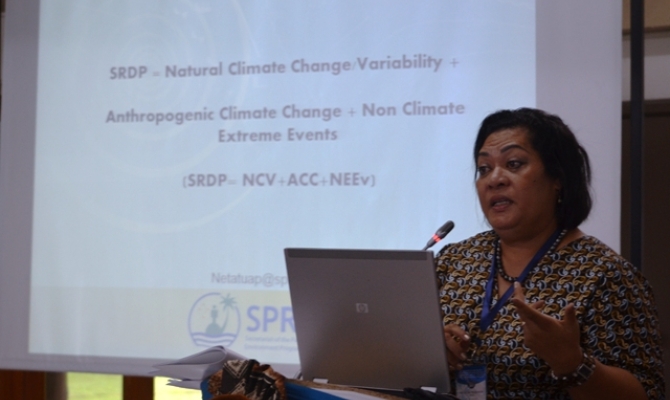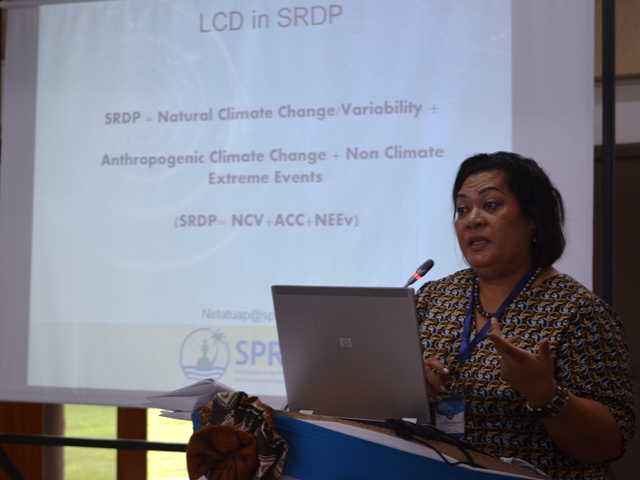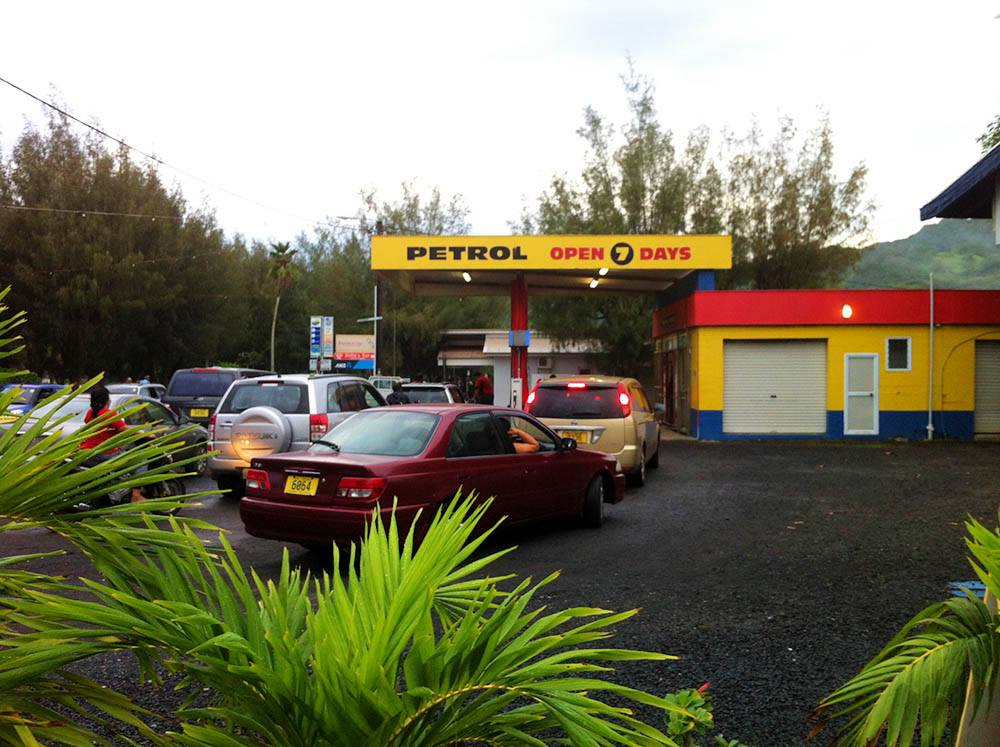
Climate Change Resilience
3 June 2014, Suva, Fiji - Low Carbon Development in the Pacific region is one of three goals of the Strategy for Climate and Disaster Resilient Development in the Pacific (SRDP), a strategy still undergoing regional consultation before final endorsement.
Bringing together two key issues, Climate Change and Disaster Management under one regional framework, development of this strategy has been ongoing since 2011.
In Fiji this week, the Strategy in its current draft was at the center of a day of discussions during the 6th Session of the Pacific Platform for Disaster Risk Management in Suva, allowing for further input.
One session focused on Low Carbon Development, one of the three goals in the SRDP. The other two being Strengthened Climate Change Adaptation and Disaster Risk Reduction as well as Strengthened Disaster Preparedness, Response and Recovery.
While the Pacific contributes to less than 0.01% of the global total of carbon dioxide emissions, the Pacific is working to minimise their emissions through renewable energy actions. This has a range of benefits that are both financial and environmental.

"Climate and disaster risks are not the only risks that causes our Pacific vulnerability, we must address all the causes of our vulnerability and deal with them overall as a package which requires more inter-sector planning and implementation," said Dr. Netatua Pelesikoti, the Director of Climate Change, SPREP.
"Carbon intensity can affect life in our region and if we increase our renewable energy usage then we are also increasing our energy security and dependency on fossil fuel, strengthening our natural capital and helping to slow the rate of climate change."
In 2010 the energy, transport and industrial sectors together accounted for over three-quarters of the total energy demand of Pacific island countries and territories.
Oil is the main energy source, meeting over two thirds of the primary and final energy demand.
The increase in the price of petroleum from 2002 to early 2008 cost most Pacific islands about 10% of their gross national incomes, with impacts falling disproportionately on those with low incomes.
Dependency on fuel also places local communities at risk.
 Photo courtesy of The Pitt Media Group, Cook Islands
Photo courtesy of The Pitt Media Group, Cook Islands
In May this year, residents on Rarotonga in the Cook Islands were rationed to 20 dollars worth of fuel equating seven litres of petrol.
The shortage was due to mechanical issues with the ships transporting fuel to Rarotonga and led to major disruptions.
The Low Carbon Development goal hopes to address issues such as these.
"Through the strategy we envisage energy production and distribution systems designed to minimise hazard risks and the negative impacts of climate change and extreme weather events. It will also lead to resilience of power generation plants, improvements in waste methods that will help enhance the resilience of natural and human ecosystems. The benefits to low carbon development are boundless."
The 6th Session of the Pacific Platform for Disaster Risk Management is co-convened by the Secretariat of Pacific Community (SPC) and the United Nations Office for Disaster Risk Reduction (UNISDR).
The Secretariat of the Pacific Regional Environment Programme (SPREP) coordinated the attendance of Pacific island Climate Change practitioners and Meteorological Service Directors for the day of SRDP consultations in Fiji.
The SRDP is a partnership effort led by SPREP, SPC, UNISDR, United Nations Development Program, University of the South Pacific and the Pacific Islands Forum Secretariat.
To access a copy of the SRDP in its current draft please contact SPREP's Climate Change Coordination Adviser Ms. Tagaloa Cooper-Halo at [email protected]
Bringing together two key issues, Climate Change and Disaster Management under one regional framework, development of this strategy has been ongoing since 2011.
In Fiji this week, the Strategy in its current draft was at the center of a day of discussions during the 6th Session of the Pacific Platform for Disaster Risk Management in Suva, allowing for further input.
One session focused on Low Carbon Development, one of the three goals in the SRDP. The other two being Strengthened Climate Change Adaptation and Disaster Risk Reduction as well as Strengthened Disaster Preparedness, Response and Recovery.
While the Pacific contributes to less than 0.01% of the global total of carbon dioxide emissions, the Pacific is working to minimise their emissions through renewable energy actions. This has a range of benefits that are both financial and environmental.

"Climate and disaster risks are not the only risks that causes our Pacific vulnerability, we must address all the causes of our vulnerability and deal with them overall as a package which requires more inter-sector planning and implementation," said Dr. Netatua Pelesikoti, the Director of Climate Change, SPREP.
"Carbon intensity can affect life in our region and if we increase our renewable energy usage then we are also increasing our energy security and dependency on fossil fuel, strengthening our natural capital and helping to slow the rate of climate change."
In 2010 the energy, transport and industrial sectors together accounted for over three-quarters of the total energy demand of Pacific island countries and territories.
Oil is the main energy source, meeting over two thirds of the primary and final energy demand.
The increase in the price of petroleum from 2002 to early 2008 cost most Pacific islands about 10% of their gross national incomes, with impacts falling disproportionately on those with low incomes.
Dependency on fuel also places local communities at risk.
 Photo courtesy of The Pitt Media Group, Cook Islands
Photo courtesy of The Pitt Media Group, Cook IslandsThe shortage was due to mechanical issues with the ships transporting fuel to Rarotonga and led to major disruptions.
The Low Carbon Development goal hopes to address issues such as these.
"Through the strategy we envisage energy production and distribution systems designed to minimise hazard risks and the negative impacts of climate change and extreme weather events. It will also lead to resilience of power generation plants, improvements in waste methods that will help enhance the resilience of natural and human ecosystems. The benefits to low carbon development are boundless."
The 6th Session of the Pacific Platform for Disaster Risk Management is co-convened by the Secretariat of Pacific Community (SPC) and the United Nations Office for Disaster Risk Reduction (UNISDR).
The Secretariat of the Pacific Regional Environment Programme (SPREP) coordinated the attendance of Pacific island Climate Change practitioners and Meteorological Service Directors for the day of SRDP consultations in Fiji.
The SRDP is a partnership effort led by SPREP, SPC, UNISDR, United Nations Development Program, University of the South Pacific and the Pacific Islands Forum Secretariat.
To access a copy of the SRDP in its current draft please contact SPREP's Climate Change Coordination Adviser Ms. Tagaloa Cooper-Halo at [email protected]